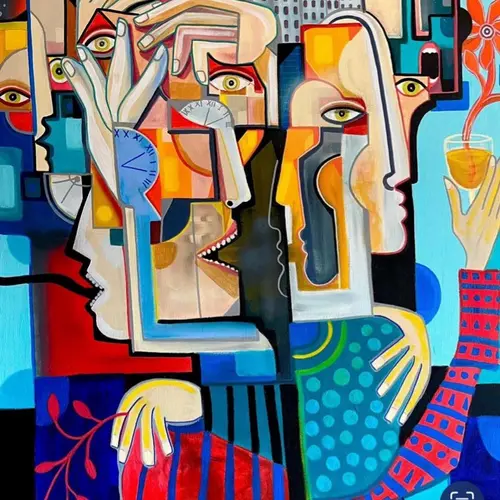BA

About
DYLAN GILL, ARTIST. LONDON. Dylan Gill’s creative practice was forged in the suburban sprawl he refers to as the “real London”—tucked far away from places like Big Ben and Piccadilly Circus that catered to bustling crowds of tourists, but no less ...
DYLAN GILL, ARTIST. LONDON. Dylan Gill’s creative practice was forged in the suburban sprawl he refers to as the “real London”—tucked far away from places like Big Ben and Piccadilly Circus that catered to bustling crowds of tourists, but no less clamorous. Born into a large, boisterous, working class family where “you had to shout to be heard”, Gill found his voice through painting. From an early age, his art served as a meditative practice that allowed him to process the noisiness of the world around him. Beneath London’s constant static hum of city crowds, advertisements, and news cycles, Gill began to notice a deeper web of affective exchange. He tuned in, not just to what was being said, but to the underlying emotional resonance that accompanied his encounters with everyone from mass media conglomerates to the people he met on the street. In a practice that emerged from these experiences, Gill opens himself up to the emotional signals that vibrate just below the noise of modern life and attempts to capture their effects on canvas, quickly, while they are still fresh in his psyche. The result is a body of works that operate in the vein of empathetic impressionism, using color, form, and symbolic imagery to transform interplays of feeling into vivid surrealist portraits. Gill points out that “everything in life is emotional response,” His work highlights the pervasive role that emotion plays in shaping the sociocultural landscape of our world. But this terrain is complex and contested. Now, more than any other time in history, humans are inundated with a flood of incoming frequencies bearing subliminal emotional weight: news programs fostering a fear of the future, advertisements cultivating dissatisfaction with the present, political rhetoric stirring up nostalgia for idealized pasts. Everything from our private interior lives to our most intimate relationships are shaped, guided, and curtailed by these external, unseen signals. Even when the effects of these emotional currents are apparent, their ubiquitous and entangled nature means that it’s not always possible to tell where they’re coming from, much less to resist their pull. “People are boxed in, but they don’t realize it,” Gill says. In the face of these competing, irrational, and often contradictory pressures it becomes necessary to adopt fractured identities that make it possible to move fluidly through the constructed confines and ambiguous expectations that constitute contemporary cultural spaces. By using skewed and fragmented perspectives in his work, Gill engages with the complexity of living in a world of alienated emotionality. His paintings often depict people in simultaneous, but compartmentalized, states of happiness, anxiety, revelry, and love—sipping wine through a straw while holding a hand to their forehead in concern, raising a flower up to their face with one hand while gazing forlornly down at a cigarette in the other, or locking eyes across the table from a dear friend while staring out a distant landscape through the window. It was only after this empathetic multiperspectivalism had developed in his early paintings that he was exposed to the works of Pablo Picasso and Fernand Léger, and eventually adopted the Cubist moniker for his own practice. By placing Gill’s work within the context of this historical lineage, it becomes possible to see how his paintings are an extension and expansion of an ongoing creative dialogue that interrogates the cracks and fissures that complicate how we think about meaning, being, and identity following the advent of modernity. Gill draws on his own sensitive attunement to the unexpressed interiority of himself and others to bring fractured aspects of complex emotional landscapes into simultaneous being. By breaking down the barriers that separate performed and suppressed feelings, he interrupts processes of psychic fragmentation and calls attention to the entangled identities, relationships, and ideologies that make up who we are. In discussion, Gill recounts a trip to Inverness and the feeling of wonder that accompanied being immersed in wild nature, an environment uninhibited by the neat rows and tidy dividers that govern the shape of urban lawns and garden spaces. His work can be seen as a move towards a sort of spiritual rewilding in this vein; an acknowledgement that a diversity of emotional experiences and a degree of inner unruliness are necessary components of a healthy mental ecology. It’s a hopeful call-to-arms against the naturalized—but, ultimately, human constructed—confinements that shape how we frame the capacity and limits of our own lifescapes. A gentle, but powerful counter-signal to the flood of external noise, reminding the viewer of the infinite possibilities that exist beyond its reach.
Curriculum Vitae
View AllBorn in 1978 in London. Currently residing in London, UK.
CUBIST KALEIDOSCOPE: Explorations of the Mind’s Canvas Embrace the Present CUBIST KALEIDOSCOPE: Explorations of the Mind’s Canvas Embrace the Present
